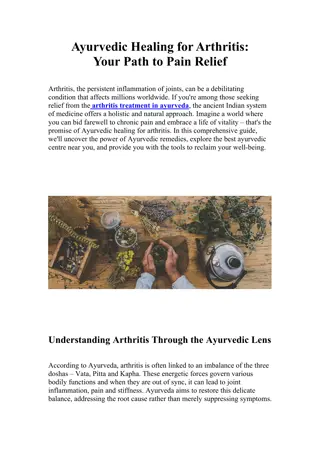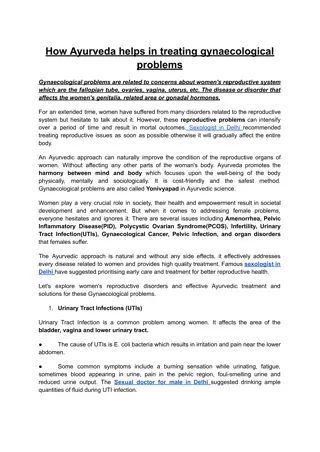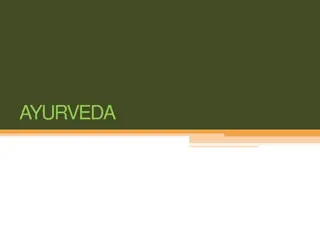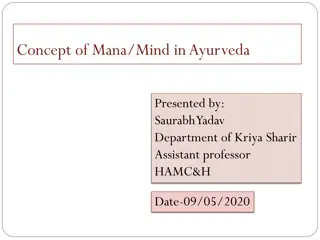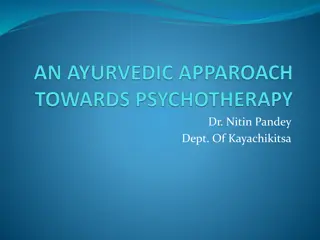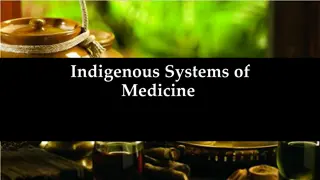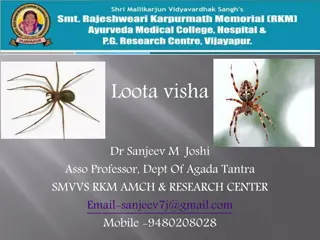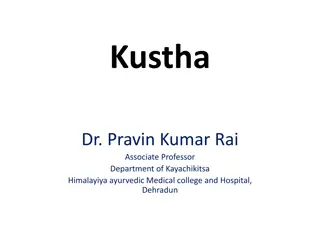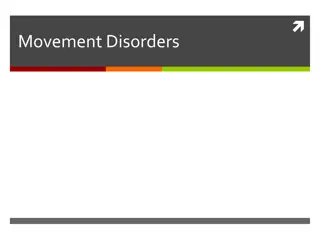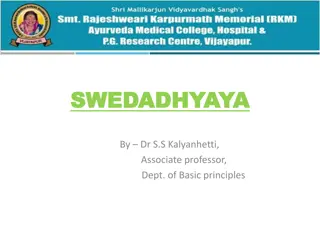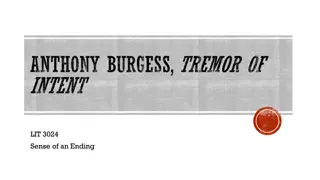Understanding Kampavata: A Comprehensive Overview of Tremor Disorders in Ayurveda
Explore the concept of Kampavata, a type of Vata disorder characterized by tremors, rigidity, and slowness of movement in Ayurveda. Learn about its symptoms, etiological factors, and insights from ancient Ayurvedic texts. Understanding Kampavata sheds light on the traditional approach to diagnosing and managing tremor-related conditions.
Download Presentation

Please find below an Image/Link to download the presentation.
The content on the website is provided AS IS for your information and personal use only. It may not be sold, licensed, or shared on other websites without obtaining consent from the author. Download presentation by click this link. If you encounter any issues during the download, it is possible that the publisher has removed the file from their server.
E N D
Presentation Transcript
Dr. Nitin pandey Dept. Of kayachikitsa
Kampavata is one among vataja nanatmaja vyadhi explined by acharya charka in sutrasthana cha.Su 20. It also is explained in the name of vepathu by various other acharyas for the disease kampavata. We don t find much reference in vedic literature pertaining to kampavata & vepathu one reference in rigveda that is indra suffered with the disease vepathu and in atharvaveda we get the reference of vepathu. It is mentioned in the charak samhita (ancient classical ayurvedic text )that if vata dosha becomes imbalance then it produces 80 types of vata nanatmaj vyadhi ( vataja disease). Vepathu is a one of them which is commonly known as kampavata. Kampavata is mainly associated with tremor (kampa), rigidity (sthambha ) bradykinesia (chestasanga). Kampa (tremor) is found as symptoms of many disease like vataja jwara, vataja unmanda,vatika kustha,vatikapandu ,urustambha etc
Contd........... Acharya Sushrut has not mentioned Vepathu as a separate disease. But he mentioned it as a symptom of many disease conditions and also complication ofArdita (facial paralysis). As per Astanga Hridaya, kampa is found as a symptom in vata prakop (vitiation of vata) and sarwanga vata. kampa is noted in raktkshaya, pittakshaya and kaphakshya condition according to Astanga Sangraha Acharya Madhava has mentioned the disease Vepathu in a separate chapter in his work Madhava Nidan in which he mentioned that Vepathu is characterized by Sarvang kampa (tremor all over body) and shirokanpa (tremor in hand). Basavaraja Author of this text has explained symptoms of kampavata, firstly provided diagnostic clue of the symptoms of Parkinson's disease i.e. Karpadatale Kampa (i.e. tremor in hands and legs), Deha Nidrabhanga (sleeplessness) and Kshinmati (loss of intellect) Bhramana (whirling sensation),
Contd..... If we study the all available literature of Ayurveda the following are the key observed symptoms of kampavata Kampa (Tremor) Sthambha (Rigidity) Chestasanga (Slowness Of Movement) Vak Vikriti (Speech Disorder) Avanamana (Flexion Posture ) Kshinamati (Dementia) Smritihani(LossOfMemory) Vivandha (Constipation) Kampa (tremor) is described to occur many parts of body including Shirakampa (tremor of the head), Oshtakampa (lip tremor), Hastakampa (tremor of the hands), Padakampa (tremor of the legs). '
ETIOLOGICAL FACTORS Nidana refers to all the causative factors which are responsible for the initiation and progress of the disease process. Nidana is defined as; Vyadhi utpatti hetu nidanam That is, nidana is the main cause for occurrence of the disease. The etiological factors of vatavyadhi in general have been described in our classics, but separate nidanas for Kampavata not explained. Kampavata is one of the vatavyadhi and it is also told that, Na kampo vayuna vina without vata, there is no manifestation of kampa In Bruhatrayis, Acharya s not mentioned particular Vepathu but they stated that all Vatavyadhi Samanya Nidana are also responsible for Vepathu. In Madhavanidan and Basavrajiyam, there are no separate Nidana mentioned by Acharyas. They considered Samanya Nidana of Vatavyadhi for Kampavata also. Nidana for
PRODROMAL SYMPTOMS Poorvaroopa is not mentioned in any where in classics the Poorvaroopa of Kampavata is considered as Avyakta. As Acharya Charaka states that, all Vatavyadhi have Avyakata poorvaroopa because the Samprapti of disease manifests suddenly due to Ashukaritva of Vayu. Some Acharyas state that Poorvaroopa is present, these Poorvaroopa are nothing but these are the Vyadhi Lakshana s which are present in very lesser extent and it is difficult to rule out these Lakshana s. Caraka say that Avyakta Laksana are the Purvarupa ofVata Vyadhi (Ca.Ci.-28/16), following may be considered as. Purvarupa of Kampavata
Contd........ Angamarda Anxiety (Udvega) Anavasthita Chittatva. Disorientation (Moha) Forgetfulness (Smriti hani) Irritability (Asvasthamana) Pain (Gatraruka) ache & pain which may be restricted to one side of the body Nervous ness (Avasada) patient felling of tension & restlessness Paresthesia (Supti) Sensation of warmth (Ushnapratiti) Tiredness (Klama)
CLINICAL MANIFESTATIONS According to Madhavakara Kampa of whole body or it is located in Shirso ( head), it is termed as Vepathu. Here the word, Shiraso not only indicates head but instead of that it presents any part of the body. Therefore, from this we can conclude that Madhavakara was very much conscious about the clinical presentations of the patients and he has considered two types of Kampavata that is Sarvanga Kampavata and Ekanga Kampavata. According to Basavrajiyam Hand and feet tremors difficulty in bodily movements disturbed sleep and memory loss these cluster of symptoms are found in Kampavata (Sarvanga Kampavata).
Contd........ Along with it Bahukampavata is explained by Basavrajiyam as --- When Tremor is located in one arm, abnormal structural changes takes place in body, all these symptoms produces difficulty and person suffers from Hand Tremors through out the day and night. Certain symptoms like----- Stambha (Rigidity) Cestahani (Slowness of the movement) Vinaman (Flexed posture) Vakvikriti (Speech disorders). Are other symptoms mentioned in some pathological conditions of Vata vyadhi which can also be grouped under the features of Kampavata
Comparison between Kampavata and Parkinsons Disease Lakshanas of Kampavata disease Symptoms of Parkinson s Kampa Matiksheena Vibandh Dehabhramana Nidrabhanga Tremor Dementia Constipation Postural changes Insomnia
PICTURES SHOWING C/ F Flexed posture in Parkinson s disease Parkinson s disease patient
Pathogenesis of Kamp Vata samprapti for Kampavata is not explained separately, so the general samprapti of vatavyadhi can be considered here. SAMANYA VATA PRAKOPA NIDANAS VRUDDHAPYA SHIROBIGHATA RAKTHADI DHATU KASHYA DHATU KSHAYA VATA PRAKOPA VITIATED VATA CIRCULATES THROUGH RASAYANIS DOSHA DUSHAYA SAMMURCHANA MANIFESTATION OF LAKSHANAS LIKE KAMPA, DEHABRAMANA, MATIKSHEENA, NIDRABHANGA KAMPAVATA
Contd...... Avarana and Dhatukshaya are the two basic processes which incite Vata while discussing the Samprapti. It was concluded that the Avarana condition also responsible for Kampavata- Kaphavritta Vyana, exhibits as Gatisanga, Daurbalyata, Gurugatrata, Chesta Stambha (Su. Ni. 1/39) and Vagbhata mentioned that Skhalita Gati (A.S.Ni. - 16/50). Kaphavritta Udana manifests as Vak Svara Graha, Gurugatrata (Ch.Chi.-28/224,225) and Kampanam. Dhatukshaya is another important phenomenon which is constantly involves in the Samprapti of the disease. Mainly Rasakshaya, Shukrakshaya Majjakshaya and Ojokshaya were contemplated as the pathological process in Kampavata Avarana manifests as Ekdeshe Vriddhi i.e. increased function at one site and decrease in other sites such phenomena is evident in Kampavata, as increased fine movement (tremor) and slowness of the movement (bradykinesia) is the hall mark of Parkinson s disease
Prognosis and principle of management Most of our acharyas consider shuddha vataja vyadhi are asadhya or krichrasadhya. So Kampavata being one of the shuddha vata vyadhi, is also krichrasadhya / asadhya for chikitsa. Kampavata being one of the Vatavyadhi, general line of treatment which is explained for vatavyadhi can be adopted by considering specific etiology. For better understanding these principles of treatment are explained under 3 headings. Shodhana Shamana Other Measures
Contd........ Acharya Vangasena has described specific therapies for the treatment of Kampavata. These specific line of treatment for Kampavata can be summarized here. Abhyanga Swedana Virechana Anuvasana basti Niruha basti Shirobasti Sneha can be administered in both ways External and Internal Abhyantara Snehas are Bhojana, Pana, Nasya and Basti Bahya Sneha are Abhyanga, Mardana, Lepa, Moordhni taila etc Charaka opines, Snehana is the first line of treatment for all Vatavayadhis, Snehana does Balavardhana, Agnivardhana and nourishes shushka dhatus.
Contd........ In the context of vatavyadhi swedanakarma like nadisweda, pindasweda, awagahasweda are mentioned which alleviate vitiated vata dosha Acharya Charaka mentioned Virechana as a shodhana karma for the treatment of Vatavyadhis. Especially for Kampavata no drugs have been mentioned. Mridu virechana with snehasamyukta oushadhis is advised in all sorts of Vatavyadhis.For Sneha Virechana Eranda taila can be given with milk.Virechana gives bala to indriyas, does agnideepana and koshtashuddhi Acharya Vagbhata has stated nasa hi shiraso dwaram i.e. nose is the easiest and closest opening for conveying the potency of medicines to the cranial cavity. The drugs administered will reach the shringataka marma and spread through the opening of siras of eye, ear and throat etc., and to the head. Acharya Chakradatta and Acharya Vangasena have indicated Nasya karma in Kampavata
Contd........ All of our Acharyas have considered Basti as best treatment for Vatavyadhi. Due to its vast action, it has been considered as the complete or half of the treatment.The appropriate adoption of Bastikarma facilitates expulsion of pureesha, shleshma, pitta, adhovata and mootra and accomplishes strength. The snehas which are used for Anuvasana basti destroys the rooksha, laghu and sheeta gunas of Vata, by their snigdha, guru and ushna properties. Niruha basti causes elimination of malas and doshas from all the srotases. Basti relives sankocha and stabdhata etc Shamana Chikitsa Some of shamana yogas are described for Kampavata are as follows. TAILA--- Nakula taila(B.R) Vijaya bhairava taila(B.R) Rasna taila(Bh. S) Sahacharadi taila(S.Y) Ksheerabala taila(A.H) Varuni taila(Sha. S)
Contd... RASAYOGAS Triguna rasa(S.Y) Vatarakshasa rasa(R.Y.S. II) Kanaka sundara rasa(R.Y.S. I) Kalavidhanasano rasa(R.Y.S. I) Gandharva rasa(R.Y.S. I) Chaturbhuja rasa(R.Y.S. I) Other Measures These modalities include--- Education - Education about disease, its management and progression to patient and their family. Support - There are many support organizations like American Parkinson s Disease Association, National Parkinson s Foundation, and Local Hospitals etc. Parkinson s disease patients can take help of these organizations by discussing their problems and struggles through the internet.
Contd...... Exercise Exercise is an important factor in the medical and psychological well being of patients. Exercise increases the patients overall health and functionality. It has a positive impact on mood and energy levels. All these factors are important in treating chronic disease. Nutrition Patients with Parkinson s disease have decreased muscle mass and more weight loss than healthy control subjects, patients should be instructed to eat healthy diet and to take multiple vitamins with calcium if needed. Yoga and Meditation -Yoga and meditation help to build the resistance and immunity in the body.They also help in the regulation and balance functioning of central nervous system



